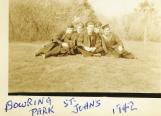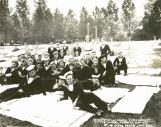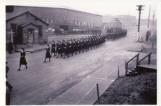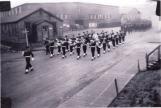1
The establishment of a naval base in St. John's brought instant change to the city. There was an economic boom as construction of facilities proceeded at a rapid pace. The population grew dramatically as Free French, British, Polish, Norwegian and American personnel flooded in. Culture changed as these new arrivals brought new forms of music and entertainment with them.2
The Red Triangle ClubNovember 1942
St. John's, Newfoundland, Canada
 Credits:
Credits:Ruby Moores Thomas Collection
3
Survivors of the Hectoria, Empire Moonbeam, Empire Oil at the Red Triangle Service ClubSeptember 1942
St. John's, Newfoundland, Canada
 Credits:
Credits:Dawn Levitz Album
Ruby Moores Thomas Collection
4
Every day and night there was something going on at the newly created Carabou Hut, Red Triangle Club, Knights of Columbus Hostel and the Seagoing Officer's Club (later known as the Crow's Nest). Naval personel enjoyed natural pleasures such as a walk in Bowring Park, a climb up Signal Hill or fishing in nearby rivers and ponds. They could even enjoy a time away from the sea at Captain D's camp located in Donovans, a short distance outside the city.5
The Riot on New Gower StreetCirca 1942
St. John's, Newfoundland, Canada
 Credits:
Credits:Jacquey Ryan
Hubert Short
6
Water Street always fascinated me because of all the coves and there was always something for a kid to look at or watch and get into difficulties at times too. I remember you know gangs of men going here and there and just off on the north side of the harbour where the piers and wharves were you wouldn't see too much on that side in the way of military shipping, most of the military shipping was as far as I can remember was out in the harbour or over on the Southside, but I remember the blackout very well, a lot of places you couldn't go anymore I never been there before, the military were filling in like Bannerman Park, I just barely remember being around Bannerman park and there was construction going up everywhere and all kinds of troops and soldiers walking around. downtown on Water Street. There was soldiers there for days and the big riot on New Gower Street, this is when the Americans supplied the 50 old destroyers to the British and the British Royal Navy sent crews over. These things had been brought up from the states and moored in Halifax and they brought the crews over from England to pick them up. Well amongst the crew that they sent over were 40 Newfoundlanders who hadn't been home since 1939. Course the place was crawling with sailors from the Royal Canadian Navy, and the two didn't intermix too good during wartime that was a different world altogether. Anyway that's when the Newfoundlanders and a lot of the Newfoundlanders were from St. John's from the old part of St. John's, I'm talking now the area between Empire Ave and the Harbour, they come home now and all of their girlfriends are going out with the Canadians. Up she goes. Anyway they cleaned out New Gower Street and my father was on duty at Buckmaster's Field with one of the Army units. He was the orderly officer for that 24 hour period. His orderly sergeant came in and said "Sir we better get the MPs down to New Gower Street". Took them, it started roughly around 8 o'clock that night and they finally cleared it up about 8 o'clock the next morning. It was a knock down drag out, and father said when him and his group of two or three got there the Constabulary were on the scene, the shore patrol were there, every military police in Christidom was there you know it was just a knock down drag out riot.7
Bowring Park1942
St. John's, Newfoundland, Canada
 Credits:
Credits:Herbert Roberts Collection
2007-2008 Album, Crow's Nest
8
When on shore sailors enjoyed outings at Bowring Park or climbs up Signal Hill. Places such as the Caribou Hut and The Red Triangle Club were homes away from home, where sailors could go to write letters, converse with other sailors and perhaps get a decent night's sleep away from the close quarters of the hammocks found aboard ships.9
Herb Roberts ClimbingCirca 1942
St. John's, Newfoundland, Canada
 Credits:
Credits:Herbert Roberts Collection
10
Blanket Washing DayMay 1941
St. John's, Newfoundland, Canada
 Credits:
Credits:Herbert Roberts Collection
2007-2008 Album, Crow's Nest
11
WRENs at HMCS Avalon, St. John's NewfoundlandCirca 1942
St. John's, Newfoundland, Canada
 Credits:
Credits:Gary Browne
Jacquey Ryan
Stanley-Saunders Collection
12
In fact there's a real interesting story about that operation from Liverpool. There was a huge building and there was a huge wall 20 feet or more high and that was the situation board and every ship crossing the Atlantic either going east or going west was positioned on that board and there was series of ladders up to the ceiling and that board was manned by WRENS, the ladies in the Royal Navy and they were up on the ladders, which is amusing in itself and the story was that one day the Admiral, (they were off to the side the Admiral and Chief of Staff for the Royal Navy Captain), they were off to one side in a glass enclosure watching the situation board and that's where it (the Battle of the Atlantic), was controlled from that room from that board by the Admiral, and the girls were positioning the ships that were sunk and the ships that were still alive, and the story goes and I am sure it is true the Admiral said to his chief of staff one day, "Captain we're going to have to do one of two things, we are going to have to move the Battle of the Atlantic into the South Atlantic where you don't have to reach so high", (the equator is down there and the north pole is up there) the girls don't have to reach so high," we're going to have to move the Battle of the Atlantic to the south Atlantic or put the WRENS in trousers".13
HMCS AvalonCirca 1942
St. John's, Newfoundland, Canada
 Credits:
Credits:Gary Browne
Jacquey Ryan
Stanley-Saunders Collection
14
Recruiting for the Royal NavyWe needed to do recruiting right away for the British services, so the chief of police became the recruiting officer and the assistant recruiting officer for the Royal Navy was Sergeant Mahoney of the Constabulary and Sergeant Mahoney, I recently saw a letter while researching my book, where the Navy people congratulated Sergeant Mahoney for the tremendous job he did early on at the recruiting until the British people came over from the British Navy and they could do it. So that alone was a tremendous working relationship you had the Chief of Police you had Sergeant Mahoney working exceptionally close and also my uncle, Sergeant Mac White was the Constabulary Drill Instructor and there was a bunch of Navy recruits that were here and they had a British Naval Officer coming over to inspect them before they went overseas, and Sergeant White, my uncle, the drill instructor, he got the men ready, the recruits and gave them drill and when the officer came over to inspect them he was quite impressed, and also Sergeant White from the Constabulary, these young recruits who were joining the Royal Navy, used to have to get their medicals and they used to march them up, they used to drill at police headquarters at Fort Townsend the old historic Fort Townsend and they would march the navy recruits from there up to Water Street west there was a naval recruiting center and they would have to get their medicals done and Sergeant White would have to march these guys back and forth so we're very proud the Constabulary of the relationship between the forces, especially the Navy and where we had these men, so I thought that was a really important role that they played in that liaison at the first part of the war until the British recruiters came over here.
Gary Browne